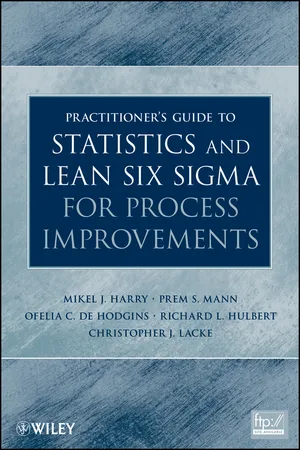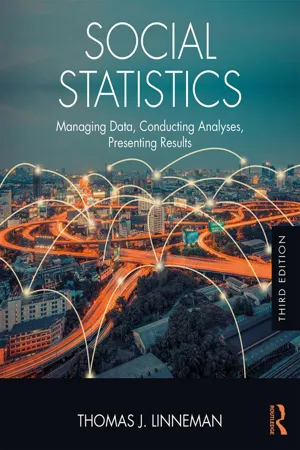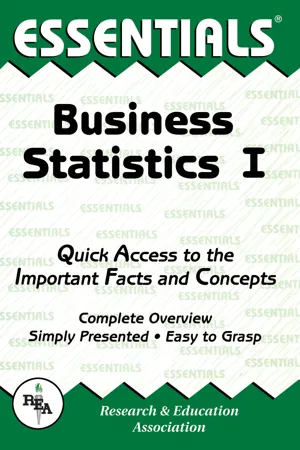Confidence Interval for Population Mean
A confidence interval for a population mean is a range of values within which we are reasonably confident the true population mean lies. It is calculated using sample data and provides a measure of the uncertainty associated with estimating the population mean. The confidence level indicates the probability that the interval contains the true population mean.
8 Key excerpts on "Confidence Interval for Population Mean"
- eBook - ePub
- Lawrence S. Aft(Author)
- 2018(Publication Date)
- CRC Press(Publisher)
...A 95 percent confidence interval would be even wider — for example, between 722.49 and 741.51.) A confidence interval is a range of values that has a specified likelihood of including the true value of a population parameter. It is calculated from sample calculations of the parameters. There are many types of population parameters for which confidence intervals can be established. Those important in quality control applications include means, proportions (percentages), and standard deviations. Confidence intervals are generally presented in the following format: Point estimate of the population parameter ± (Confidence factor) (Measure variability) (Adjusting factor) A number of formulas have been developed for particular cases. The remaining sections of this chapter will present, illustrate, and interpret these formulas as they relate to quality control. Confidence Intervals for Means The way a confidence interval for means is developed depends on the sample size. As noted earlier, the larger the sample size, the better the estimate. Statistically, large samples are arbitrarily defined as those with 30 or more members. Small samples have fewer than 30 members. Either a z value or a t value is needed to represent the level of significance in confidence interval formulas when one is dealing with averages. Other probability distributions are used when dealing with confidence intervals for other statistics, such as standard deviations. z Values For large samples, the standard normal curve is used to specify the confidence. The value corresponding to the confidence is the z value. Example 5.1 What z value corresponds to an α of.05 or 95 percent confidence? Solution We are looking at a confidence interval for which the area outside the interval is symmetrically distributed...
- eBook - ePub
- Mustapha Abiodun Akinkunmi(Author)
- 2019(Publication Date)
- De Gruyter(Publisher)
...In most cases, we use a 95% confident limit for the estimation—this implies that we can say that our estimation about a population plausibly falls within the specified range of values in 95 out of 100 cases. For instance, a researcher may like to know the number of cars traveling a road on a daily basis. A traffic study over several days concludes that the average number of cars traveling a road daily is between 180 and 200. This scenario can be represented as the normal curve shown in Figure 9.1. Figure 9.1: Confidence interval of the average number of cars traveling a road daily. 9.2 Confidence Intervals for Mean If a sample is drawn many times, there is a certain percentage of assurance that a range of values computed from the sample will probably contain an unknown population parameter—this percentage is the confidence interval. A confidence interval is the probability that a value will fall between the upper and lower bound of a probability distribution. Suppose an analyst forecasted that the return on the Dow Jones Industrial Average (DJIA) in the first quarter of the year will fall within -0.5% and +2.5% at a 95 percent confidence interval. This means that the analyst is 95% sure that the returns on the DJIA in the first quarter of the year will lie between -0.5% and +2.5%. Confidence intervals (CIs) can be used to bound numerous statistics such as the mean, proportion, and regression coefficients (Chapter 11). A confidence interval is constructed as follows: C I = s a m p l e s t a t i s t i c ± c r i t i c a l v a l u e × s t a n d a r d e r r o r o f e s t i m a t e For example, if the sample size n < 30, σ is unknown, and the population is normally distributed, then we should use the Student’s t-distribution...
- eBook - ePub
Statistical Misconceptions
Classic Edition
- Schuyler W. Huck(Author)
- 2015(Publication Date)
- Routledge(Publisher)
...Chapter 7 Estimation Students can be left with many misconceptions after a standard introductory discussion [of confidence intervals]. One frequent misconception is that a 99% confidence interval is narrower than a 95% confidence interval. Students also tend to misinterpret the confidence interval by considering it to be a fixed quantity, not recognizing its dependence on the particular sample observed. Another common misconception is that the interval is a statement about the distribution of the data, rather than a set of possible “guesses” for the mean of the distribution generating the dataset. * 7.1 Interpreting a Confidence Interval The Misconception If a 95% confidence interval (CI) has been created to estimate the numerical value of a population parameter, the probability of the parameter falling somewhere between the endpoints of that interval is equal to.95. Evidence of This Misconception * The first of the following statements comes from an online document entitled “What Are Confidence Intervals?” The second statement comes from a statistics textbook. In contrast [to tests of null hypotheses], confidence intervals provide a range about the observed effect size. This range is constructed in such a way that we know how likely it is to capture the true—but unknown—effect size. Thus the formal definition of a confidence interval is: “a range of values for a variable of interest [in our case, the measure of treatment effect] constructed so that this range has a specified probability of including the true value of the variable. The specified probability is called the confidence level, and the end points of the confidence interval are called the confidence limits.” A confidence interval is a range of values constructed to have a specific probability (the confidence) of including the population parameter. For example, suppose a random sample from a population produced an X̄ = 50. The 95% confidence interval might range from 45 to 55...
- eBook - ePub
Medical Statistics
A Textbook for the Health Sciences
- Stephen J. Walters, Michael J. Campbell, David Machin(Authors)
- 2020(Publication Date)
- Wiley-Blackwell(Publisher)
...In fact, as Figure 5.5 shows values just outside the interval do not differ substantively from those just inside the interval. It is thus wrong to claim that an interval shows all possible values. Not all values inside the confidence interval are equally compatible with the data, given the assumptions. In Figure 5.5, the point estimate is the most compatible value, and values near it are more compatible than those near the lower and upper limits. In strict terms the confidence interval is a range of values that is likely to cover the true but unknown population mean value, μ. The confidence interval is based on the concept of repetition of the study under consideration. Thus, if the study were to be repeated 100 times, of the 100 resulting 95% confidence intervals, we would expect 95 of these to include the population parameter. Consequently, a reported confidence interval from a particular study may or may not include the actual population parameter value of concern. Figure 5.6 illustrates some of the possible 95% confidence intervals that could be obtained from different random samples of 25 babies from the 3226 babies whose birthweight data was recorded by O'Cathain et al. (2002). Ninety‐four (94%) of these 100 confidence intervals contain the population mean birthweight of 3.39 kg but 6 (6%) do not. This is close to what we would expect – that the 95% confidence interval will not include the true population mean 5% of the time. Figure 5.6 One hundred different 95% confidence intervals for mean birthweight constructed from random samples of size 25...
- Mikel J. Harry, Prem S. Mann, Ofelia C. De Hodgins, Richard L. Hulbert, Christopher J. Lacke(Authors)
- 2011(Publication Date)
- Wiley(Publisher)
...As we continue to examine the intervals, note that the confidence interval formed from the 28th sample falls completely above 4850, as does the confidence interval formed from the 44th sample. The interval from the 42nd sample falls completely below 4850. Therefore, we have 47 samples that result in intervals that contain 4850 and three that do not. In other words, 94% of our 50 samples produce intervals that contain the population mean. If we were to continue this process by taking a very large number of samples of 35 observations, we would find that the percentage of resulting confidence intervals that include 4850 would be very close to 95%. Thus, the confidence level is the percentage of all confidence intervals made using the same sample size that will contain the parameter of interest. Similarly, the confidence coefficient is the probability that the method of forming a confidence interval will result in an interval that contains the parameter of interest. 14.3 ESTIMATING A POPULATION MEAN Most books will provide the use of two distributions (the normal distribution and the t distribution) for calculating a confidence interval for a population mean. The primary reason for demonstrating the z interval for a population mean is that it utilizes the normal distribution, which was covered in Chapter 12. This allows one to concentrate on the foundations of a confidence interval without having to worry about a distribution with which one is unfamiliar. The primary reason for demonstrating the t interval for a population mean is that it is the commonly used method in practice, as the z interval involves an assumption that is typically unrealistic in practice. 14.3.1 Confidence Interval for a Population Mean Using the Normal Distribution As we mentioned earlier, the formation of a confidence interval involves a point estimate and the properties of its sampling distribution...
- eBook - ePub
Social Statistics
Managing Data, Conducting Analyses, Presenting Results
- Thomas J. Linneman(Author)
- 2021(Publication Date)
- Routledge(Publisher)
...You’ve probably heard confidence intervals called by a different name: margins of error. Margins of error are typically reported any time you hear poll results: “People prefer Candidate W to Candidate L 56% to 44%, with a margin of error of 3 percentage points.” In the field of statistics, however, we tend to call them confidence intervals. If confidence is involved, about what exactly are we saying we are confident? When we have a sample mean and want to make an inference and talk about the population mean, we can develop an interval within which we are confident that the population mean falls. We don’t know exactly what the population mean is (if we did know this, then why would we need to sample in the first place?), but we have strong reason to believe it’s not greater than this, and not less than that. For example, what if I were interested in building a confidence interval using the inequality concern index results from the young liberals previously? With the sample mean of 11.54, within what range can I confidently claim that the population mean falls: 11.44 to 11.64 (that is, ±.10)? 11.24 to 11.84 (that is, ±.30)? 10.79 to 12.29 (that is, ±.75)? 10.04 to 13.04 (that is, ± 1.50)? 9.54 to 13.54 (that is, ± 2.00)? 8.54 to 14.54 (that is, ± 3.00)? There’s tension here. On one hand, we want to be as specific as possible: saying that the population mean is between 8.54 and 14.54 isn’t very specific and doesn’t really help us use the sample results to describe what is going on in the population. On the other hand, we also do not want to be incorrect: saying that the population mean is between 11.44 and 11.64 is very specific, but claiming this doesn’t do us much good if the chances are high that the population mean is outside of this range. In other words, we would likely be making a type I error...
- eBook - ePub
Social Statistics
Managing Data, Conducting Analyses, Presenting Results
- Thomas J. Linneman(Author)
- 2017(Publication Date)
- Routledge(Publisher)
...We don’t know exactly what the population mean is (if we did know this, then why would we need to sample in the first place?), but we have strong reason to believe it’s not greater than this, and not less than that. For example, what if I were interested in building a confidence interval using the meeting index results from just above? With the sample mean of 4.69, within what range can I confidently claim that the population mean falls: 4.59 to 4.79 (that is, ±.10)? 4.39 to 4.99 (that is, ±.30)? 3.94 to 5.44 (that is, ±.75)? 3.19 to 6.19 (that is, ± 1.50)? 2.69 to 6.69 (that is, ± 2.00)? 1.69 to 7.69 (that is, ± 3.00)? There’s tension here. On one hand, we want to be as specific as possible: saying that the population mean is between 1.69 and 7.69 isn’t very specific and doesn’t really help us use the sample results to describe what is going on in the population. On the other hand, we also do not want to be incorrect: saying that the population mean is between 4.59 and 4.79 is very specific, but claiming this doesn’t do us much good if the chances are high that the population mean is outside of this range. In other words, we would likely be making a type I error. So we want a happy medium, and the procedure for building confidence intervals is how we find that happy medium. Speaking of happiness, the level of confidence with which most people are happy is 95%. Recall that, when we performed chi-square tests, we wanted p to be below 0.05. We allowed ourselves a 5% chance of making a type I error. Here we’ll use a similar idea: we’ll allow a 5% chance that we could be wrong, but we want to be correct 95% of the time, thus the term “95% confidence interval.” Some people want to be more sure and want to allow only a 1% chance of error, so we will also cover, you guessed it, a 99% confidence interval. But we’ll start with 95%. So we can be wrong 5% of the time...
- eBook - ePub
- Louise Clark(Author)
- 2014(Publication Date)
- Research & Education Association(Publisher)
...We have seen that estimates are made either as point estimates (the sample mean) or as interval estimates (confidence intervals). The number of items (n) to be included in a sample (i.e., sample size) is a function of three components: 1. the maximum error desired by the user(s) of the information; 2. the level of confidence desired by the user(s) of the information; and, 3. the degree of variation or dispersion of the data points within the population and consequently the sample. where: n = sample size Z = standard normal score from the Table of Areas Under the Standard Normal Curve - based on the degree of confidence specified by the user(s) of the information σ = population standard deviation E = maximum error allowed by the user(s) of the information As indicated above, in order to determine the sample size (n) needed in a given situation, in addition to the information provided by those who plan to use the information, the value of σ, the population standard deviation is required. It is conceivable, although not likely, that this value might be available from some past study or prior knowledge. When the value of σ is not known, it must be estimated by the value from a pilot study, which is a small sample selected for the purpose of estimating a value to be used for σ. EXAMPLE: A sample is to be selected from the sales receipts of the Cute Clothing Store so that an estimate can be made as to the average amount spent per purchase at the store within the past month. The store manager wishes the estimate to be made with 95% confidence and specifies that the maximum acceptable error for this estimate should not exceed $5. Assume that a pilot study revealed an estimated population standard deviation to be $25...







